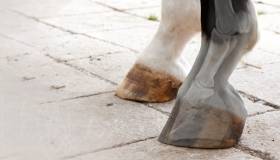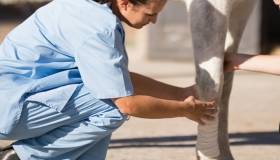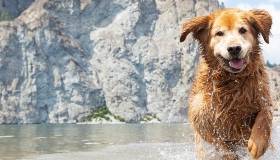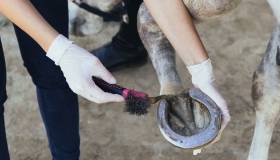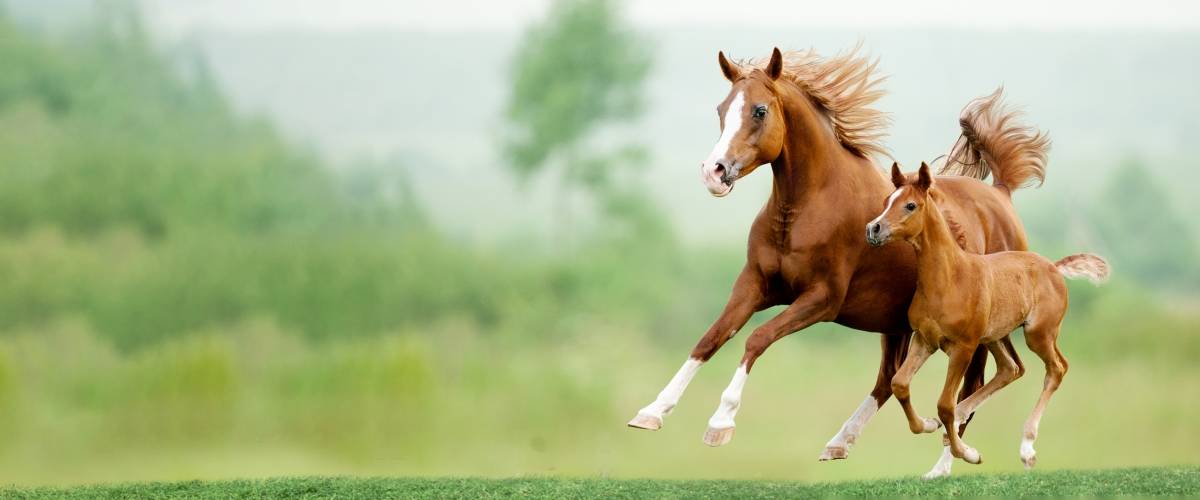
July 8, 2021 – It’s no secret that when horses sustain bone or tendon injuries, not only their athletic careers but their very lives are threatened. One possible solution is a defined exercise program. Dr. Annette McCoy, an assistant professor of Equine Surgery at the University of Illinoi-Urban-Champaign, joins us to discuss her new study looking at how exercise programs in foals could prevent orthopedic injuries later in life.
Additional resources: https://www.morrisanimalfoundation.org/article/foal-exercise-bone-development
0:00:11.5 Dr. Kelly Diehl: Welcome to Fresh Scoop, episode 34, does exercise help young horses avoid injury. I'm your host, Dr. Kelly Diehl, Morris Animal Foundation, Senior Director of Science and Communication. And today we'll be talking for a second appearance with Dr. Annette McCoy. Dr. McCoy is an assistant professor of Equine Surgery at the University of Illinois-Urbana-Champaign. And welcome back, Annette.
0:00:35.8 Dr. Annette McCoy: Thank you for having me.
0:00:37.4 DD: So before we get started, I know we probably covered this the last time you were on, but can you tell us again a little bit about yourself and what led you to veterinary medicine?
0:00:45.8 DM: Sure, so I was definitely one of those kids that decided from a young age that I wanted to be a veterinarian... We all have that story about how we were 12 years old and decided that this is what we wanted to do, and that was definitely the case for me. To be honest, I'm not... I don't have a good reason why. I just decided that that's what I wanted to do, and I followed that path. But I grew up all over, interacted with lots of different people in different places, and really grew to love the science and the question and answer aspect of medicine, and so managed to stay true to that goal and get there in the end.
0:01:29.5 DD: So great, and... What do you think led you to surgery and then... Obviously, specifically equine surgery.
0:01:37.6 DM: So I have to give a lot of credit to my mentors in vet school. When I came into vet school, I knew I wanted to specialize because I loved the side of things where you would get presented with this complex problem and have to figure out what it was and what the best thing to do was to treat it. But... And honestly, I hadn't really decided on small animal versus large animal when I started, and I had fabulous mentors on the large animal side, both equine and food animal, and they really steered me in that direction. And I loved horses. Obviously, that was also a draw for me, but really it was one of those situations where the influence of the people who trained me really steered me in the direction, and I'm very happy that that turned out that way.
0:02:28.2 DD: Yeah... I know that we have students listening and I would just make a quick detour to keep your mind open when you go to vet school, because surprisingly, even though I'm a boarded a small animal internist, I started out as a food animal person... And it just... You just keep your mind open. And you go, "You know, I fit better here."
0:02:49.7 DM: Absolutely.
0:02:51.3 DD: "Than here." So everybody listening, keep your mind open when you go to vet school. Before we get into the details of your project Annette can you talk a little bit about some of the orthopedic problems that you see in young horses. And I know this is a big topic, but if you can also speak a little maybe about their frequency and obviously their impact.
0:03:11.0 DM: Sure, of course. So when I think about orthopedics and foals, I think about three general categories of things. So we think about infectious or septic orthopedic problems, which we often see in our neonates. So right after they're born... Maybe they have a systemic infection and it goes to their bones or their joints. And so that's the infectious category, which we see... I see it more often because I'm in a referral hospital... But in general practice, it's fortunately not tremendously common, but it is definitely something we worry about with the little babies.
0:03:45.2 DM: And then we have the category of disease that is developmental orthopedic disease. And so this is a huge umbrella. It covers a lot of different specific diseases that include osteochondrosis, wobblers disease, fasciitis, angular and flexural limb deformities... And there's lots of different verbiage out there that surround this big developmental umbrella. But the bottom line is that these are things that become apparent during the first few months of life. Sometimes quite early in life. They may be born with these issues or they may develop them over the first year. And those are conditions that are not as often life-threatening, but they certainly can impact career and they can be life-threatening when very severe.
0:04:34.8 DM: But those are things that will commonly intercede in anywhere between a few days of age and a year of age. And then the third category is trauma, which can happen to any horse at any time, but in the real young horses, we are thinking about accidental stepped on kicked, got stuck under a fence, those types of things. As they get a little bit older and they're running and playing around, stepping in a hole... All that kind of stuff.
0:05:03.0 DM: And that again, during that first year of age, these are sort of accidental traumas. As they get a little bit older and they move into training and their careers, then we see the traumatic injuries that are associated with their jobs. And so while the developmental stuff is not something that we can necessarily prevent... Although certainly that's another aspect of my research... We're trying to look at that third category, the trauma category, and see if there is something that we can do intervention-ally at a young age to help prevent that third category...
0:05:38.0 DM: The developmental orthopedic diseases certainly affect a much larger number of foals. In some breeds, up to 80% of foals may be affected with some form of developmental disease, but the devastating injuries... The ones that are truly traumatic, those are the ones that we are trying to figure out how to prevent.
0:06:00.6 DD: So... And that's... I think most people understand, even if they are small animal folks or lay people listening, that when a horse breaks a limb, it's a bad, bad problem. But can you expand on it a little bit for maybe people who aren't as familiar or God forbid, have never had to... Hopefully deal with this with their horse. And discuss why fractures are just so bad in horses.
0:06:24.3 DM: Yeah, absolutely. So there's a couple of different factors that you have to consider. So one is size. Horses are big, and we are always fighting a battle of implant strength... So if we go in and we put in screws or plates to fix a fracture, we have to hope that those stay strong enough to keep things in place while everything heals. And there are special implants that we use for horses that are larger than the ones that are used for people or for small animals, but we're still fighting that sort of maximum strength and resilience of those implants. And horses, like I said, they weigh a lot.
0:07:04.9 DM: And that goes into the second piece of it, which is horses can't be recumbent for long periods of time... They can't lay down. So if your dog breaks its leg, he can lay in his bed at home for weeks and only get up to go to the bathroom, and eat and he'll be fine. Whereas horses don't have that same physiological capability. They can lay down and they do lay down, but they tend to get other health problems when they do. Some of that's related to just their physiology. So the way their GI tract works, the way their feet work, and some of it is, again, because of size. So we end up with a lot of issues with sores and other management type issues that are a real struggle.
0:07:48.8 DM: And then the third component of it, there's just some things that we can't fix. And so luckily, in the lower limb, there are many things that we can fix, but higher up in the leg... So femurs, humerus, scapula, the things that are a challenge to fix in small creatures are impossible to fix in horses. And so unfortunately, that's why many fractures are life-threatening or life-ending in horses when they could potentially be fixed in a smaller creature, but we're just fighting against biomechanics.
0:08:23.5 DD: Right. And I would think that also we're talking about a big cost, right?
0:08:29.0 DM: Absolutely. Yeah, and that is completely leaving out the economic side of things. So fractures are expensive to repair... Not just the surgery and the implants, which have a substantial cost attached to them, but also the after care... So it's not like we fix them and they get to go... Throw them out into a field. There are complications that are associated with even the best repairs. And I think the classic example of this that most people know about is Barbaro.
0:09:00.3 DM: Barbaro had his injuries repaired by one of the best surgical teams in the world, and they did a brilliant job piecing him back together, but he developed support limb laminitis in his other foot. And there's just nothing we can do about that. It's one of the great tragedies of equine surgery is that they can develop this problem, and we at this point have nothing to do to fix it. And so even though his fracture was repaired, and was repairable, in the end we lost him because of those post-operative complications.
0:09:31.1 DD: Okay. So we're going to move to... I wanted to ask you of course about your study. So let's take a high level first. So first, what did you hope to accomplish and kind of why this study was important? And I think you just gave us a sense, but if you could elaborate on that.
0:09:47.4 DM: Yeah, so fractures in horses, especially race horses are a matter of a great emotional impact for the general public. Not only for the people who are directly involved with the cases. Of course, it's a horrible experience for them, but they tend to be highly visible, especially in race horses. And so a lot of non-horse people are aware of them, and it's very traumatic to watch a horse break down in a race. And I want to emphasize that fractures are not just a race horse disease, they can happen to any horse at any time, it's just that we see them on TV, when they're race horses.
0:10:28.4 DM: And so there are many people out there that are doing wonderful research to try to figure out why fractures happen and what kind of things we can do to help prevent them. So they look at track surface, they look at training regimens, they look at shoeing... All of these different things... Nutrition, drug use, all of these things. We are trying to take a look earlier. So is there something that we can do to help prepare equine athletes from a young age to be more intrinsically resistant to the fractures that they encounter as adults?
0:11:07.9 DM: And here, we're not talking about the fracture that they get because they step in a hole or because they get kicked. These are the repetitive traumatic, chronic stress-related fractures that are a direct result of the exercise that they do for their jobs. So we are trying to figure out, can we from the beginning, build a better and stronger bone that is more resistant to those repetitive forces that they encounter in their jobs as adults.
0:11:38.8 DD: Okay, and walk us a little bit through your methods, like what you're doing there.
0:11:44.3 DM: Sure. Absolutely, so we actually started with just observing what was normal... Because nobody's ever really taken a close look at how normal foals just out in pasture, how they grow and develop their bone structure and their gait over that first year of life. It's just something that we haven't looked at much. And so we started there. And what we found was that for those bones in the distal limb horses actually are disproportionately weak in those bones relative to their size as they grow. And these aren't horses that are confined or anything like that. These are horses that are living in a pasture doing what horses do, but their bones are lagging behind in terms of strength relative to their change in mass... Their change in weight over time.
0:12:41.1 DM: And so that led us to the idea that this was an opportunity for us to do some kind of an exercise intervention that might kick start that bone development early in life, and then potentially that could have prolonged benefits later in life. So we have a cohort of foals. We have a Standardbred farm here at Illinois that we use the foals that are born and raised there. And we have half of them that are just our controls. They are turned out on pasture, they do their thing. And then we have another cohort, of the exercise cohort that are being asked to exercise for short periods of time, five days a week for eight weeks.
0:13:26.6 DM: So between eight and 16 weeks of age, these foals are asked to follow their moms at... Between a trot and a sprint depending on the... How old they are and what they are capable of for a defined period of time, five to 10 minutes on a daily basis. And then we follow these foals with imaging. So they get serial computed tomography or CT exams, and that lets us determine what the relative density is in the bone. And not just how dense the bone is sort of as a whole, but on a slice-by slice basis, we can look at where are they laying down the bone. Is it on the inside? Is it on the outside? Is it at the top? Is it at the bottom? And then we can use that to figure out, are they laying down bone in those places where later in life, we know that fractures are likely to happen.
0:14:17.9 DD: So I have another quick question, because it just came to me was, do you know... Maybe you can't answer why you think their lower limbs lag. And is it a Standardbred thing, or is it... Like, have you demonstrated it in other breeds of horses?
0:14:34.8 DM: It's a great question. We haven't looked at it in other breeds of horses it's something that would be really interesting to do. I suspect that it's just because of how bone gets laid down... So, bone develops in response to Wolff's law, which is... It's the idea that we think about when you have a cast and you lose bone mass... So it's use it or lose it... So bone gets laid down preferentially in areas that experience stress and strain. And that's mechanical stress and strain... And it gets taken away in areas that don't have a lot of stress and strain.
0:15:14.2 DM: And if you've ever watched babies in the field like puppies, they play really hard and then they sleep really hard. And we have done observational studies over a series of several years of foals in their natural setting, and what we've observed is that they spend 80% of their time doing nothing. They are sleeping, they are standing quietly, they are eating. And so that natural tendency to be fairly inactive is most likely why they're not building up bone very rapidly in those first few weeks of life.
0:15:49.7 DM: And what we don't know is, is that imbalance something that would continue through skeletal maturity or is that something that they catch up on as they get older and a little more aggressive in their play. If you see yearlings playing with each other, they play much harder than these eight to 16-week-old babies. So that's a question that we don't know the answer to yet. But because horses get put into training before they're skeletally mature for many types of work, it becomes a really important question as to when they get... When they hit that catch-up phase, if that actually happens... And that's certainly a question that will be interesting to think about in the future.
0:16:41.3 DD: Okay. So that's... That... You mentioned, Wolff's law and the laying down of bone. So talk about why you think exercise can help. I think we just got a sense from what you said, which is the... Putting a little stress.
0:16:56.2 DM: Exactly. So there's good evidence from others that exercise induces bone development. So we know that it's been demonstrated both in animals and in people. And so when you exercise and you have that mechanical stress and strain that triggers the body to lay down new bone. And so we're really just capitalizing on the body's natural physiological functions to stimulate or trigger that response. And again, the idea is, can we do it earlier in life to help jump-start the process.
0:17:37.5 DD: Okay, so what do you think you're going to find? Again, you've sort of alluded to it, but what is your hypothesis?
0:17:46.4 DM: Yeah, so we have a little bit of preliminary data that suggests that this relatively mild exercise intervention does result in increased bone being laid down. This is in a tiny handful of foals. So obviously, it's something that we're hoping to validate in our current study that is going to have a larger number of foals in it. And so we're interested in two things. We're interested in the idea of overall bone strength like how much bone is there, bone volume or bone density, but also location of bone being laid down. And again, in one foal that we've done the complete analysis on, we showed that there is a shift in where that bone is preferentially being laid down, if you think about it as sort of a circle, a cross-section.
0:18:38.8 DM: The bone that under non-exercise conditions is preferentially being laid down on the inside of the bone, simply because that's where the forces are from standing. When they're exercised it's more evenly distributed around the bone. And so we're looking for both a change in total bone properties, but also that sort of regional bone property. And we're hoping that the exercise again makes a stronger bone overall.
0:19:08.9 DD: So based on the outcome of your study then... And I know you're in the middle of it... What do you think you're going to do next once you're done?
0:19:17.3 DM: Yeah, so the next part is really heavy on the engineering side. And I have a wonderful colleague Dr. Mariana Kersh who is my dear colleague on this, who is doing all of the bio-mechanics piece of this. She and her team are taking these data... So we have imaging data from the CTs, we have motion capture data, so kinetic and kinematic data, and we're putting this all into a computer model. So it's a musculoskeletal model, so it's a virtual horse... A virtual foal.
0:19:52.6 DM: And so the idea is, if we can take these data and build an accurate algorithm... So one where we feed in what we did and it spits out what we get at the end of it, then what we can do is use that model and we can feed in different exercise programs, different parameters and get it to predict what the outcome will be. And that will help us to optimize an exercise program that we can then recommend to people for their young horses and say, "If you do X, then the result will be Y." And hopefully, the long-term result will be fewer injuries in our athletes.
0:20:32.1 DD: Right, because I would think... And I don't know if anyone's ever done this, or if you know this, but I know there's a lot of discussion in humans... Like, "Oh, we're going to throw our kids out and have them do lots of soccer." And they worry about just having kids... Myself... Repetitive injury at a young age and stress. So I'm thinking this would help maybe find a sweet spot...
0:20:52.8 DM: Yeah.
0:20:56.0 DD: With that. Have there ever been studies on too much exercise... I think for horse athletes, there probably is some stuff about when they're adults maybe.
0:21:04.5 DM: Yeah, absolutely. So we definitely know that there is that fine line between... For lack of a better term, stress and distress. So there are absolutely overuse injuries that happen. We see those very commonly, particularly in tendons... So tendon injuries and stuff, we very commonly associate with that. There is a wonderful longitudinal study that was done several years ago by a group in New Zealand that had a similar idea to what we're doing, where they took these horses, they exercised them, and then they followed them up through their careers.
0:21:37.1 DM: And that study really is a big part of the idea behind making things better. And that group looked at tendons and bone and all of the other pieces of the equation and found that there were benefits to early exercise. But again, that was one protocol. And our hope is that we can experimentally get a good enough computer model that we can say exactly as you said, where is that sweet spot? Where is not enough? Where is too much? Where do we need to be with these guys in the middle?
0:22:14.2 DM: And obviously, eventually that will need to get tested in horses. But, if you throw in 20 exercise programs and the computer says these three we're pretty sure are going to be the best... Well, now we can conceivably test those three versus the 20 live cohort of horses and validate that. And say, "Yup, the program was right, this is what we should be doing for these horses."
0:22:39.2 DD: Right. Right. Well, that's a good point, the way you discuss that, because I think we do that... We think about that more as far as our Golden Retriever Lifetime study, which is a longitudinal study. It's just really supposed to... It's observational... So you can make some observations, but then doing what you're doing, which is coning down on one aspect, so we can get some hard data that... We can then look at. And developing an algorithm that would save a lot of time, I think...
0:23:08.3 DM: Well, a lot of time in animal use... One of our key concepts as animal researchers is reduce the use of live animals whenever possible. So if we can really focus our efforts on the things that are most likely to yield good benefits, then that's good for everybody, right?
0:23:33.6 DD: Right, right, exactly. So as we're getting ready to wind down, I wanted to ask you what other projects you're working on.
0:23:39.4 DM: I've always got other things on perhaps. So obviously developmental orthopedic disease as we discussed the last time we talked is a huge focus for me. I'm really interested in looking at the genetic aspects of DOD, particularly osteochondrosis. Again, I use the Standardbreds as my model. They're a wonderful breed and they have a high incidence of osteochondrosis so they're great for that. So we are... With our other Morris funded project, we are digging deeper into the genetics of that disease.
0:24:14.3 DM: And then I have other projects going on looking at gait. Again, Standardbreds are great for that because they pace and they trot, and we're trying to figure out what in the brain gives them the ability to do that. And we're building off of great work by other people in the field. And then a new area of interest for one of my graduate students is looking at gastrointestinal inflammation in horses, trying to diagnose it, trying to prevent it, trying to treat it.
0:24:42.1 DD: Wow.
0:24:42.9 DM: So those are our big areas right now.
0:24:44.8 DD: So that's a new one. As a GI person, I'm like, "Wow, very good." I don't think I would want... You would not want me doing any orthopedic stuff, I'm sure.
0:24:54.6 DM: Well, it's a new area for us, so we'll be excited to see where that goes in the next couple of years.
0:24:58.6 DD: Right, so that's good. So just to finish up, Annette what message are you telling people that you see in clinic, horse owners and veterinarians you consult with when it comes to... Let's just start with fractures, what's your take home message for them?
0:25:17.1 DM: Yeah, to be honest, for the average horse owner, a fracture is hopefully something they'll never encounter. It tends to be a catastrophic event. I guess I would say that, as with anything, prompt veterinary attention is critical. Unfortunately, I've seen cases where the injury went unrecognized and there's less that we can do about it, the longer that it's been since the injury happened. The other reality is that there are just some things that we can't fix. But there are brilliant people doing brilliant work, helping us develop better implant so that hopefully that won't be the case in the future. But just to take care. Avoid the things that you can avoid. But understand, that there are things that can't be avoided.
0:26:10.5 DM: For people who have their horses in training, especially young horses in training, give them time as much as you can. Because the more skeletally mature they are, the more ready their bodies are for the work that you're asking them to do. And just like you wouldn't send your six-year-old to the Olympics... You're not going to get the most that you can out of a skeletally immature individual as an equine athlete.
0:26:40.1 DM: So I think as a community, we need to be more aware of what we're asking them to do. But I think the bottom line is... Is that none of us would ever wish a fracture on anybody, but there are many horses that have fractures that are treated and go on and return to their athletic lives and never look back. And so it's not necessarily a death sentence. Certainly there are cases that we can't fix, but work as a partner with your veterinary to come up with the best plan for your individual situation.
0:27:21.5 DD: Well, that's really good advice, I think. And I think the timely advice, like you said, recognizing something early. And that kind of goes for a lot of diseases... Right. And particularly, I think for fractures in horses the sooner the better.
0:27:37.9 DM: Absolutely.
0:27:41.5 DD: Well, that does it for another episode of Fresh Scoop. So thanks again. Annette was brave enough to come on a second time, and I can't tell you how much we appreciate, Annette. We've pestered her... I've pestered her many times for things, and I really, really enjoy having you on Annette, so thank you.
0:28:00.9 DM: Thank you.
0:28:02.1 DD: So everyone, we'll be back with another episode next month that we hope you'll find just as informative. The science as we know of animal health is ever-changing and veterinarians need cutting edge research information to give their patients the best possible care. And that's why we're here. As always, you guys can find us on iTunes, Spotify, Google podcast and Stitcher. And if you liked today's episode we'd sure appreciate it if you could take a moment to rate us since that really helps people find us in the sea of podcasts, that is our reality right now.
0:28:35.8 DD: And of course, to learn more about the Morris Animal Foundation's work, go to morrisanimalfoundation.org, and there you'll see just how we bridge science and resources to advance the health of animals. You can also follow us on Facebook, Twitter and Instagram. And I'm Dr. Kelly Diehl, and we'll talk soon.

